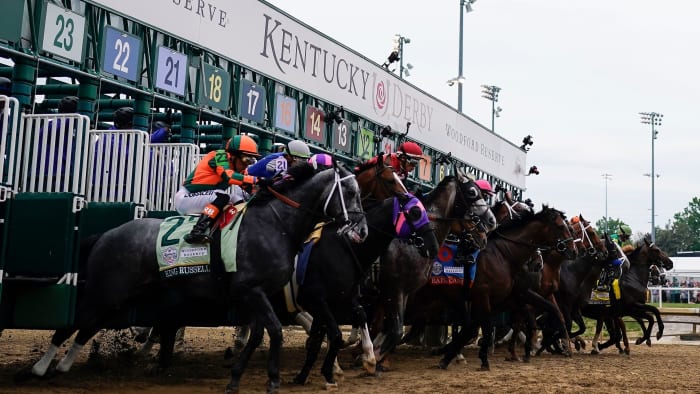The dominant news of the day in Kentucky on May 17, 1875, was the death of John C. Breckinridge, a U.S. Congressman turned Confederate Civil War general. Breckinridge died at the age of 54 at his home in Lexington, Ky., a divisive historical figure. His obituary filled several columns in the next day’s The Courier-Journal newspaper.
On page 4 of that Courier-Journal, a relatively modest headline read, “Derby Day.” The accompanying story chronicled the Kentucky Derby victory by the colt Aristides, in what the paper termed “a brilliant inauguration of the Louisville Jockey Club Association.” The founder of the association was Meriwether Lewis Clark Jr., grandson of William Clark, one of the principals in the Lewis and Clark Expedition.
The originator of the Derby traces his sire line to the early days of the United States, when President Thomas Jefferson commissioned two explorers in 1804 to traverse the newly acquired Louisiana Purchase. That’s how deeply intertwined the Kentucky Derby is with American history.
The Courier-Journal declared that first Derby day to be “a great success at every foist, and the promise of the future assured.” That promise has been kept. That future has remained assured far longer than the newspaper could have envisioned at the time.
The 150th Kentucky Derby will be run Saturday, the longest continuously contested sporting event in the United States. The race predates the automobile and the airplane, radio and television, Edison’s light bulb and Einstein’s relativity. It is the anchor of American sporting longevity.
Wars, contagions and economic calamities have not unmoored it. World War II necessitated moving the 1945 edition to June, but the race was run. The COVID-19 pandemic couldn’t cause a cancellation, though it did present such a threat that the 2020 race was pushed into September. Evolving societal tastes, concerns about equine safety, a million other things to do—none have interrupted an event that began with Ulysses S. Grant in office, one decade after Robert E. Lee surrendered to him at Appomattox Court House.
There were 37 states in the union at the time of the first running. The Rose Bowl, which began in 1901, is called the Granddaddy of Them All—but the Derby could be the Granddaddy’s daddy.
From 1877 winner Baden-Baden to Joe Biden, the Derby abides. From 1899 winner Manuel to Lin-Manuel Miranda, the Derby endures. From 1958 winner Tim Tam to TikTok, the Derby prevails.
In a world of unsettlingly swift change, the sameness of the Kentucky Derby is a powerful force. The traditions are immovable.
It has always been run at Churchill Downs, named for two men who were cousins of Clark and provided the land for the track in Louisville’s South End. It has always been run on the dirt course. It has always been a race for 3-year-old horses. It has, since 1896, been a 1¼-mile race, shortened from the 1½ miles of the first 21 runnings. That’s never going to change.
For 146 of the 149 previous editions, it has been run in May—and since 1946, the first Saturday, specifically. The dogwoods bloom, the Kentucky bluegrass grows thick and the Derby comes, every spring. On the calendar of iconic vernal sporting events, there is the Masters, the Derby and the Indianapolis 500. The Derby is 59 years older than the former and 36 years older than the latter.
Churchill isn’t quite Saint Andrews, which was established in 1843, but it’s ancient by American sporting venue standards. The signature Twin Spires were built atop the grandstand in 1895, 17 years before Fenway Park unveiled its Green Monster. The white-paneled grandstand has been remodeled many times, with additions and enhancements annually (a spectacular $200 million, multilevel paddock addition debuts this year), but it retains an old-world feel.
The history is palpable. The names of every Derby winner are on the grandstand walls in chronological order; the barn area on the backside of the track is timeless. Walk by Barn 42, peep in Stall 21, and it’s easy to imagine Secretariat’s chestnut head poking out of there 51 years ago, before Big Red broke the Derby record at 1 minute, 59⅖ seconds, a legend in the making. Listen to the horse’s hooves thump on the dirt during predawn training and you can envision the great Citation doing the same thing, in the same place, 76 years ago.
For the 150,000 patrons who will flood the massive property on Central Avenue on Saturday—at lamentably exclusive prices, with the cheapest admission tickets now soaring to $130—the same rituals play out every Derby day. What keeps these traditions alive? Simple but powerful things: cold, hard cash; nostalgia; vague romance; one hell of a party; and an incredibly dramatic two-minute race.
The allure of making a buck on who wins and loses is deeply ingrained in sporting culture, but horse racing might have been the original gambling gateway drug. It’s an old sport that embraced wagering early on and never let go. With most American sports betting illegal outside of Las Vegas for decades, racetracks were one place to get down a few bets without needing a bookie and a low profile.
Correspondingly, there are generations of Americans who went to the racetrack with their parents and saw them place wagers (maybe two dollars, maybe $2,000) at the windows. There is a throwback appeal to buying an actual, print Daily Racing Form or track program, decoding the hieroglyphics of the past-performance charts, then handing over paper currency in exchange for a betting slip. (More and more racing fans conduct business on their phones, of course, but mutuel clerks are by no means extinct.)
The romance stems from a slightly different form of nostalgia. Nobody wears formal attire to sporting events anymore—except at the Derby. This is the women-in-hats, men-in-seersucker capital of the world, a dress-up day that runs the fashion spectrum from classy to gaudy. (The fit checks help make the Derby a highly Instagrammable event, which boosts popularity with younger generations.)
Mint juleps must be consumed, even if those purchased from track vendors would make high-end mixologists cringe. Cocktail culture has had a renaissance in America, but at Churchill Downs, it never left. The party aspect is very much part of the Derby experience for many patrons. (When it’s time to stagger out after about 10 hours on-site, a large number of those beautiful people are drunk, dazed and disheveled—and wishing they wore more sensible shoes.)
The race itself is exquisitely unchanged. The horses and jockeys still largely do their jobs in the same way they always have (though training methods and breeding philosophies have changed more substantially). Thoroughbreds are faster today than they were in the 1870s, but not necessarily faster than in the 1970s. (They’re also less durable.)
Then and now, they’re beautiful animals in motion and at rest, which is part of what has always drawn talented writers to the sport. When you combine all the elements of the Derby—the massive crowd, the revelry, the buildup to the razor-sharp tension of the competition itself—the elements of romantic storytelling are always present. From the great Sports Illustrated writer William Nack, recounting his first Derby as a teenager in 1958:
“I can still see the writers gathered around that coppery bright chestnut, Silky Sullivan, already a stretch-running immortal, as his groom gave him a sudsy, warm bath on the patch of grass outside his barn. … The sun was up and counting change at her old lemonade stand in the sky, and a thin patina of sweat made Tim Tam’s chocolate coat glisten in the tree-sifted light. He was coming to the race beautifully, his eyes afire, as though lit by a Bedouin torch passed down through generations, from the windswept deserts of Arabia to the ancient rolling leas of England and Kentucky.”
Similar passages could be written this week, though perhaps not as lyrically. The morning gallops, the sudsy baths, the sunbeams warming horses and humans—the eternal Derby week sensory experiences have been handed down. So, too, have the rhythms of the race—the explosion of noise when the starting gate opens, the charge into the first turn, the jockeys parrying for position through the backstretch and making bold moves on the far turn, the withering stretch run to the finish line as roars rain down, the jubilation of the winners. Two minutes and change packs a reliable emotional wallop.
Despite that sameness, each year carries its own sense of urgency. This is a once-in-a-lifetime event for the equine competitors. A thoroughbred foal crop of some 30,000 is whittled down across three years to no more than 20 who load in the starting gate. “You don’t get any do-overs,” says trainer Todd Pletcher, who will saddle favored Fierceness on Saturday.
Massive amounts of brain power are exerted in trying to figure out who will win, but then the gates open and randomness is in play. In a two-minute event, a single jockey calculation or miscalculation can make all the difference. A single stroke of good or bad racing luck can decide who goes down in history. Some horses, like Seattle Slew in 1977, confirm their greatness on Derby day. Some horses fluke their way into fame and fortune; the last two Derby winners, Rich Strike in 2022 and Mage in ’23, never won another race.
The first Kentucky Derby game story in The Courier-Journal in 1875 rhapsodized about the performance of Aristides: “Right gallantly did the game and speedy son of Leamington and Sarong answer the call on his forces, for he held his own all down the stretch in spite of the most determined rushes on the part of Volcano and Verdigris, and slashed under the wire the winner of one of the most fastest and hardest run races ever seen on the track.”
Saturday, they will run that race for the 150th time. Same as it ever was. Same as it ever will be.





